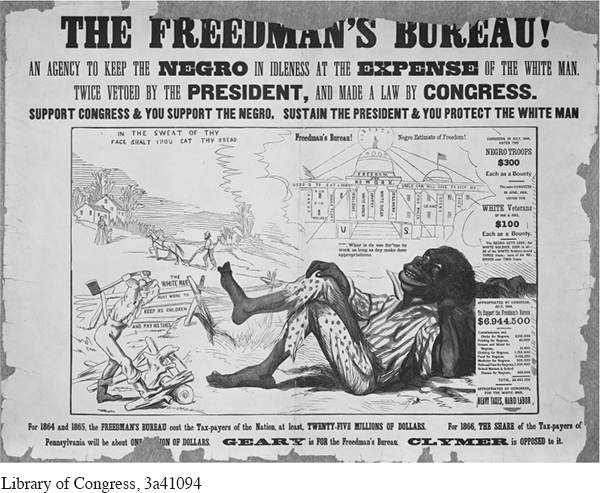Comparative Analysis Debating the Freedmen’s Bureau Documents 14.2 and 14.3
COMPARATIVE ANALYSIS
Debating the Freedmen’s Bureau
From the start, the Freedmen’s Bureau generated controversy. To its Republican supporters, it helped southern blacks make the transition from slavery to freedom. For most white Southerners and many northern Democrats, however, the bureau was little more than an expensive social welfare program that rewarded idleness in blacks. Both points of view are represented in the following documents. In a report written to the Congressional Joint Committee on Reconstruction, Colonel Eliphalet Whittlesey, the assistant head of the Freedmen’s Bureau in North Carolina, outlined the bureau’s initial accomplishments. The anti-bureau cartoon reprinted here was created during the height of the conflict over Reconstruction between the Republican Congress and President Andrew Johnson; it was intended to support the election of a Democratic candidate for governor of Pennsylvania, an ally of Johnson.
Document 14.2
Colonel Eliphalet Whittlesey | Report on the Freedmen’s Bureau, 1865
All officers of the bureau are instructed—
To aid the destitute, yet in such a way as not to encourage dependence.
To protect freedmen from injustice.
To assist freedmen in obtaining employment and fair wages for their labor.
To encourage education, intellectual and moral. . . .
. . . [W]e have in our camps at Roanoke Island and Newbern, many women and children, families of soldiers who have died in the service, and refugees from the interior during the war, for whom permanent provision must be made. . . . The reports prepared by Surgeon Hogan will show the condition of freedmen hospitals. In the early part of the summer much suffering and mortality occurred for want of medical attendance and supplies. This evil is now being remedied by the employment of surgeons by contract. . . .
Contrary to the fears and predictions of many, the great mass of colored people have remained quietly at work upon the plantations of their former masters during the entire summer. The crowds seen about the towns in the early part of the season had followed in the wake of the Union army, to escape from slavery. After hostilities ceased these refugees returned to their homes, so that but few vagrants can now be found. In truth, a much larger amount of vagrancy exists among the whites than among the blacks. It is the almost uniform report of officers of the bureau that freedmen are industrious.
The report is confirmed by the fact that out of a colored population of nearly 350,000 in the State, only about 5,000 are now receiving support from the government. Probably some others are receiving aid from kind-hearted men who have enjoyed the benefit of their services from childhood. To the general quiet and industry of this people there can be no doubt that the efforts of the bureau have contributed greatly.
Source: The Reports of the Committees of the House of Representatives Made during the First Session, Thirty-ninth Congress, 1865–1866 (Washington, DC: Government Printing Office, 1866), 186–87, 189.
Document 14.3
Democratic Flier Opposing the Freedmen’s Bureau Bill, 1866

Interpret the Evidence
According to Colonel Whittlesey, what needs does the Freedmen’s Bureau address? How does he measure the bureau’s success?
Why might this portrayal of the Freedmen’s Bureau have appealed to some whites. North and South? How would Whittlesey and other bureau supporters have responded?
Put It in Context
How did prevailing racial assumptions shape both the cartoon and the report?
Exploring American HistoriesPrinted Page 461
Chapter Timeline